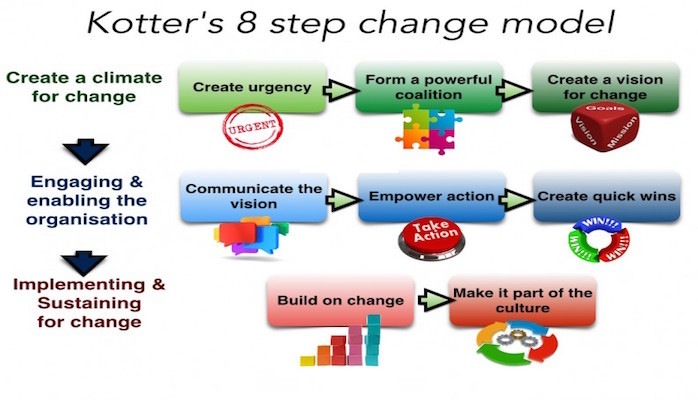Change, the only constant in the business world, demands strategic navigation. Amidst this turbulence, John Kotter’s 8-Step Model for Change Management stands tall as a lighthouse guiding organizations through stormy seas. Yet, beneath its surface lies a world of challenges and alternatives waiting to be explored. This article embarks on a voyage to unravel the depths of Kotter’s model, illustrating real-world applications, HR scenarios, and its pros and cons while navigating towards alternative shores for smoother transitions.
Kotter’s 8-Step Model in Practice:
Embarking on our journey, let us first anchor ourselves in real-life examples where Kotter’s model has steered organizations towards success.
Establishing a Sense of Urgency:
Importance: Creating a sense of urgency is vital to initiate change because it motivates stakeholders to recognize the need for action and to prioritize change efforts over business as usual. Without urgency, complacency can set in, hindering progress.
How to Achieve: Leaders can establish urgency by highlighting market trends, competitive threats, or internal challenges that necessitate change. This can involve sharing data, market analysis, or testimonials from industry experts to illustrate the need for action. Effective communication is key to conveying the urgency convincingly.
Creating a Guiding Coalition:
Importance: Change rarely succeeds through individual efforts alone. A guiding coalition, composed of influential leaders and stakeholders across various levels of the organization, provides the collective power and support needed to drive change initiatives forward.
How to Achieve: Identify key stakeholders and leaders who have the authority, expertise, and influence to champion the change effort. Engage them early on, communicate the vision, and align their interests with the change agenda. Foster collaboration and build trust within the coalition to ensure alignment and commitment to the change goals.
Developing a Vision and Strategy:
Importance: A compelling vision serves as a beacon guiding the organization towards a desired future state. It provides clarity and direction, aligning efforts and motivating stakeholders to work towards common objectives. Strategy outlines the approach and actions required to realize the vision.
How to Achieve: Collaboratively develop a clear and inspiring vision that articulates the desired future state of the organization. Ensure the vision is ambitious yet achievable, resonates with stakeholders, and is aligned with the organization’s values and objectives. Develop a comprehensive strategy that outlines the steps, milestones, and resources required to achieve the vision.
Communicating the Change Vision:
Importance: Effective communication is essential for ensuring that the change vision is understood, embraced, and internalized by all stakeholders. Transparent and consistent communication fosters trust, reduces resistance, and promotes alignment towards common goals.
How to Achieve: Develop a communication plan that outlines key messages, channels, and audiences for communicating the change vision. Use various communication channels such as town hall meetings, email updates, intranet, and one-on-one discussions to reach different stakeholder groups. Tailor messages to address concerns, highlight benefits, and reinforce the importance of the change.
Empowering Employees for Broad-Based Action:
Importance: Empowering employees involves giving them the autonomy, resources, and support needed to contribute to the change effort actively. Empowered employees are more engaged, innovative, and committed to driving change from within the organization.
How to Achieve: Delegate decision-making authority, provide training and development opportunities, and foster a culture of collaboration and experimentation. Encourage employees to take ownership of change initiatives, share their ideas and feedback, and contribute to problem-solving efforts. Recognize and reward employees for their contributions to the change effort.
Generating Short-Term Wins:
Importance: Celebrating early successes helps build momentum, morale, and credibility for the change initiative. Short-term wins demonstrate progress, validate the change approach, and motivate stakeholders to continue their efforts towards achieving the larger change goals.
How to Achieve: Identify quick-win opportunities that can be achieved relatively quickly and demonstrate tangible benefits or improvements. Celebrate and publicize these wins to acknowledge the efforts of individuals and teams involved, boost morale, and inspire confidence in the change process.
Consolidating Gains and Producing More Change:
Importance: Consolidating gains involves reinforcing the changes made, embedding new behaviors and practices into the organizational culture, and leveraging momentum to drive further change initiatives. It ensures that progress is sustained over the long term.
How to Achieve: Evaluate the impact of the change efforts, identify areas of success and improvement, and adjust strategies as needed. Institutionalize change by updating policies, processes, and systems to support new behaviors and practices. Engage employees in continuous improvement efforts and encourage ongoing learning and adaptation.
Anchoring New Approaches in the Culture:
Importance: Cultural change is fundamental to sustaining long-term change. Anchoring new approaches in the culture involves embedding new values, beliefs, and behaviors into the fabric of the organization, ensuring that they become ingrained and enduring aspects of organizational identity.
How to Achieve: Foster a culture of openness, adaptability, and continuous improvement that aligns with the desired change objectives. Lead by example, promote role modeling of desired behaviors, and reinforce cultural norms through recognition, rewards, and performance management systems. Encourage feedback and dialogue to ensure that cultural change is embraced and internalized at all levels of the organization.
By diligently following each step of Kotter’s model and paying attention to its nuances, organizations can navigate change successfully, driving sustainable transformation and achieving their desired outcomes.
Pros and Cons of Kotter’s Model:
As we navigate, let us inspect the hull of Kotter’s model, identifying its strengths and weaknesses.
Pros:
- Provides a structured framework for managing change.
- Emphasizes leadership, communication, and employee involvement.
- Focuses on generating quick wins to maintain momentum.
- Acknowledges and addresses emotional aspects of change.
Cons:
- Sequential nature may not suit all change contexts.
- Limited emphasis on continuous evaluation and adaptation.
- Relies heavily on top-down leadership, potentially stifling innovation.
- Offers limited guidance on sustaining long-term change beyond initial implementation.
Charting Alternate Courses:
To navigate around these obstacles, let us explore alternative models that offer smoother sailing.
- ADKAR Model:
- Addresses individual change readiness, mitigating resistance.
- Provides a more granular approach to tackling resistance at each stage.
- Lewin’s Change Management Model:
- Offers an iterative approach with its unfreeze-change-refreeze framework.
- Encourages continuous evaluation and adaptation, adapting to changing tides.
- McKinsey 7-S Framework:
- Considers multiple dimensions of organizational change, fostering holistic transformation.
- Provides a comprehensive view of organizational dynamics, facilitating sustainable change.
As we conclude our voyage through the depths of change management, Kotter’s 8-Step Model remains a stalwart companion in turbulent times. However, by charting alternate courses offered by models like ADKAR, Lewin’s, and McKinsey’s, organizations can navigate change with greater agility and resilience. In the ever-changing seas of business, the key lies not in steadfast adherence to one model but in the adaptability to navigate diverse currents towards the shores of success.











